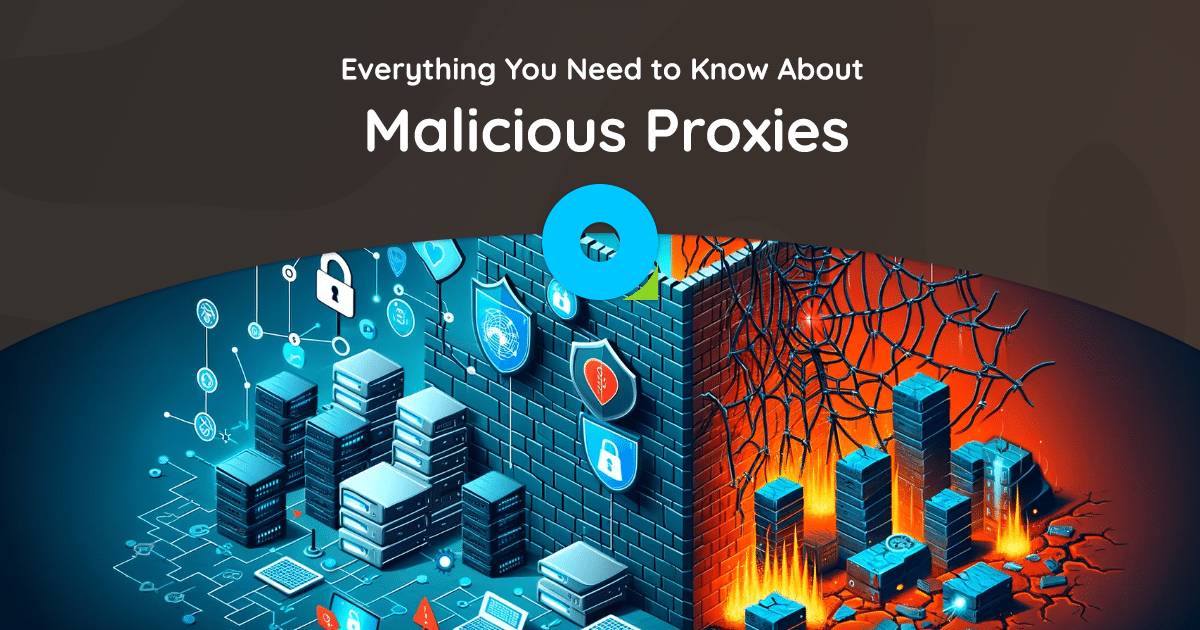
The proxies that many of us trust so much can, however, be quite dangerous.
Despite the whole world of limitless possibilities that the Internet environment gives us, it is also fraught with its fair share of dangers! In this digital jungle, where online security is of utmost importance, proxy servers often become our trusted allies. However, even with these seemingly indispensable tools, there is a dark side – the world of malicious proxies.
While the best solutions are aimed at protecting your online presence, deception can lurk in the most unexpected corners. I will shed light on the dark side of proxies, highlighting the risks and intricacies of malware. I hope this helps you and let’s get started already!
Malicious Proxy Servers Are…
These are proxy servers that are specifically configured and used with malicious or deceptive intent.
Unlike legitimate proxies, which serve a variety of practical purposes—such as increasing online privacy and security or accessing geo-restricted content—malicious proxies are designed to exploit users, compromise their security, or engage in illegal activities.
Here are some key features…
- Hidden Intentions: Such servers are created with ulterior or nefarious motives, often for personal gain or other purposes, which in any case negatively affects ordinary users.
- Data interception: They can intercept and monitor data passing through them, potentially compromising the confidentiality and integrity of sensitive information.
- Phishing and distribution of malicious programs: Some hacked proxy servers launch phishing attacks or distribute malware, infecting users’ devices. This, in turn, can lead to a number of serious problems, from loss of accounts to constant monitoring (for example, through your webcam).
- Identity theft: Malicious proxies may be designed to steal login credentials, financial information, or personal information to commit identity theft or fraud.
- Bypassing security measures: Cybercriminals can use such technology to bypass security protocols, firewalls, or content filtering, making it easier to carry out illegal activities.
- Botnet management: Such proxy servers can be part of a botnet infrastructure, allowing attackers to remotely control compromised devices.
- Traffic redirection: They can redirect users to malicious web pages, such as phishing sites or fraudulent online stores.
- IP spoofing: Malicious proxy servers can use IP spoofing techniques to hide the source of their attacks, making it difficult to trace their origin.
- Imaginary plausibility: Some malicious proxies are initially designed to appear legitimate in order to deceive users.
How Does a Proxy Server Become Malicious?

Proxy servers are a double-edged sword in the digital world. On the one hand, they can serve as valuable allies in improving online security and privacy, but on the other, they can play a sinister role when actors with ill intentions infiltrate…
Proxy Hacking: Dark Transformation
Typically, the transition from a benign proxy to a malicious one occurs when the intermediary server is hacked, manipulated, or infiltrated by individuals or organizations with “devious agendas.” Proxy hacking is a sophisticated cyberattack technique with serious consequences, the ultimate goal of which is to deceive users and exploit their trust in proxy services.
Deceptive Imitation and Traffic Manipulation
One of the main goals of proxy hacking is to replace a legitimate website in the search engine index and search results pages. By doing this, the attacker aims to redirect online traffic from the genuine site to a fake website that he controls. This manipulation of search engine results can serve a variety of purposes, including:
- Secret delivery of malware (drive-by): This is the worst possible scenario. Criminals can use proxy hacking to inject malware, viruses, or other add-ons into the victim’s computer. Users unknowingly visit fraudulent sites, resulting in potential infections and data leaks.
- Competitive advantage: Attackers can also use proxy hacking to gain an advantage over their competitors. By redirecting traffic to their fraudulent website, they can undermine the competition and gain greater market share. This strategy may also be motivated by the desire to generate advertising revenue by increasing site visits.
But There Is Another Scenario…
Malicious proxy servers may use other sneaky tactics that differentiate them from content replication. Unlike simply copying content to another website, these proxies secretly position themselves between the target site and the user, manipulating and intercepting content before it reaches the user’s view. Their main goal is to remain unnoticed by the user, invisibly use their influence, and not change the ranking in search engines.
These proxies operate in the shadows, focusing on covertly altering content to their advantage. The goal is not to change the site’s visibility in search results, but to manipulate the user’s experience of the hacked site.
Alternative Names and Origins
If you dig deeper, then in fact the process of hacking a proxy server includes several different actions and attacks, namely:
- SEO attack
- Content extraction (most often through scraping)
- Page hijacking
- Pagejacking
It is the process of illegally copying legitimate website content (usually in source code form) onto another website, intended to copy the original website. The attacker’s goal is to illegally redirect traffic from the original site to cloned web pages. Hackers rely on search engines to index fake site content to ensure that search results are ranked and displayed on the original site.
Interestingly, the term “proxy hacking” has become common knowledge in the field of cybersecurity and search engine optimization (SEO) thanks to the work of Dan Thies, an SEO expert. The identification and exposure of the then-new type of attack, the so-called “Black Hat SEO” in 2006, attracted the attention of the digital community in 2007.
How to Protect Yourself From Proxy Hacking: Protecting Your Digital Assets

Proxy hacking and the accompanying risk of infiltrating and manipulating online content is a major threat in the digital sphere. Completely protecting a website from proxy hacking and duplicate content can be challenging, but there are now important strategies and best practices that site owners and organizations can use to protect against these attacks and minimize their impact.
Find out more!
Strengthening Domain Authority
One fundamental approach to protecting against proxy hacks is to increase your domain authority. By strengthening your website’s authority, you make it more difficult for attackers to access your content and improve your site’s ranking in search results. To achieve this, you will need to implement white hat SEO methods, which include the following strategies:
- High quality keywords and links: Use quality keywords and create authoritative backlinks to your content. This not only improves your site’s visibility, but also increases its authority in the eyes of search engines.
- Canonical references: Use canonical links and sitemaps to clearly identify the source of your content. This reduces the effectiveness of typosquatting attempts (in other words, attempts to hack (code 302) URLs), making it much more difficult for proxy hackers to manipulate your content.
Protection Against Automatic Content Extraction
Blocking automatic content retrieval is another important aspect of protecting against proxy hacking. Companies are strongly encouraged to take steps to prevent malicious bots and third-party search engines from scraping and crawling their domains. Here are a few proactive steps I encourage you to consider going forward:
- Blocking bots: Implement management and filtering tools to block malicious bots from accessing your website. This will reduce the risk of your content being removed and used for proxy hacking.
- Scrape shields: Use scraper shields to disguise your content and make it less attractive to malicious scrapers.
- Collaboration with web servers and CDNs: Take advantage of modern web servers and content delivery networks (CDNs) that offer specialized tools to combat bots and filter unwanted traffic.
Regular SEO Audits: Lifetime Guarantee
Conducting regular SEO audits should be an integral part of your proxy hack defense strategy. These audits serve as a proactive approach to identifying potential proxy compromise attempts and quickly taking corrective action. Regular SEO audits help with the following:
- Early detection: Detect any unusual or suspicious changes in your search engine rankings or site traffic that may indicate a proxy hack.
- Content verification: Verifying the uniqueness of your content and ensuring it is distinguishable from potentially duplicate proxy pages.
Recognizing Characteristic Features
If you suspect a proxy server has been hacked, you should be vigilant in recognizing the telltale signs. To identify potential proxy pages, follow these steps:
- Unique phrases: Find phrases that should be unique or nearly unique to your content. Your home page should stand out in search results for these phrases.
- Duplicate Content: If you find duplicate content of yours, it may be a proxy page created for malicious purposes.
Proxy page URLs usually have distinctive features. One such feature might be, for example, including a full link to another domain in the URL, which clearly indicates that there is something wrong with it.
For example, a malicious link might look like this: www.terriblewebsite.com/nph-proxy/http/www.techtsarget.com/definition. See how it says “http” and “www” in the middle of the link? Usually they are only at the beginning of the link, while “.com” should be at the end of the domain name.
How Ordinary Users Can Minimize the Risks of Interacting With a Malicious Server
In the digital age, protection from malicious proxy servers is essential as cybersecurity threats lurk around every virtual corner.
Here’s a step-by-step guide to help you protect your online activity from the hidden dangers of malicious proxy servers!
- Stay up to date: Before you take preventive measures, learn more about the latest cybersecurity threats and tactics, including malicious proxy servers. Read reputable cybersecurity blogs (such as our website), subscribe to security newsletters, and review best practices.
- Use reliable networks: Whenever possible, connect only to trusted and secure networks. Avoid public Wi-Fi networks for sensitive online activities as they are more susceptible to man-in-the-middle attacks and malicious proxies.
- Refer to secure connection protocols: Use secure and encrypted connection protocols for websites and applications. Make sure the websites you visit use HTTPS instead of HTTP. You can also install browser extensions that provide a secure connection when possible.
- Keep all software updated: For security purposes, regularly update your operating system, browsers and software. Updates often contain fixes for previous vulnerabilities that could be exploited by malicious proxy servers.
- Enable a virtual private network (VPN): Consider using a reliable VPN service. VPNs encrypt your Internet traffic, making it difficult for malware to intercept and manipulate the data. Make sure you choose a VPN with a no-logging policy.
- Use a reliable antivirus program: Research and install a proven program that includes real-time scanning and malware detection. Update your antivirus database regularly to stay protected from the latest threats.
- Be careful with emails and links: Be careful when clicking on links or downloading ANY attachments in emails. Check the authenticity of the sender and avoid suspicious links or emails from sources you don’t know.
- Enable two-factor authentication (2FA): Enable 2FA wherever possible, especially for critical online accounts such as email and banking. Two-factor authentication always provides an extra layer of security, protecting access to your accounts.
- Beware of phishing: Phishing emails and websites often try to scam users out of sensitive information. Check the legitimacy of websites and requests for personal information.
- Regularly monitor your online accounts: Review your online accounts and check them for any suspicious activity. Report any unauthorized access or unusual behavior immediately.
- Educate yourself and teach others: Educate yourself and educate your colleagues about online security best practices. The more people are aware of potential threats, the better protected your digital community is.
- Use firewalls: Firewalls are a barrier to unauthorized access and can help prevent malicious proxy attempts! Yes, it’s as simple as that.
- Back up your data regularly: Back up your data to external or cloud storage. In the event of a security breach, having backup copies is a guarantee that you will not lose important information.
Ensuring Absolute Safety: Why Choosing OneProxy Guarantees Secure and Threat-Free Proxy Server Use
Using OneProxy proxy servers ensures absolute safety and poses no threats due to several key reasons:
- Advanced Security Protocols: OneProxy implements state-of-the-art security protocols that safeguard data transmission. These protocols encrypt data, making it unreadable and secure from interception or tampering by unauthorized parties.
- Strict Privacy Policies: OneProxy adheres to stringent privacy policies, ensuring that user data and activities remain confidential. The company does not log or monitor user activities, providing an additional layer of privacy.
- Regular Security Audits and Updates: To maintain high security standards, OneProxy undergoes regular security audits. These audits help in identifying and addressing potential vulnerabilities promptly. Additionally, the system is frequently updated to protect against the latest threats and exploits.
- Robust Infrastructure: OneProxy’s infrastructure is designed for resilience and security. It includes features like DDoS protection and load balancing, which ensure reliable and secure connectivity, even under high demand or potential attack scenarios.
- Professional Support Team: The support team at OneProxy is knowledgeable and equipped to handle security-related inquiries and issues. They provide timely assistance and guidance, ensuring that any concerns are addressed swiftly.
- Compliance with Global Standards: OneProxy complies with international security standards, ensuring that the service meets globally recognized benchmarks for data protection and security.
- Isolation from Malicious Networks: By using OneProxy servers, users are isolated from potentially harmful networks. The proxy servers act as a buffer, screening out malicious traffic and preventing direct attacks on the user’s network.
- Customizable Security Settings: Users have the option to customize security settings based on their specific needs. This flexibility allows for a tailored security approach, enhancing protection where it is most needed.
- High-Quality Server Selection: OneProxy uses only high-quality, reputable servers in its network. This ensures that the infrastructure itself is secure and not prone to vulnerabilities that might be present in lower-quality servers.
- Transparent Operations: Transparency in operations and policies at OneProxy builds trust. Users are well-informed about how their data is handled and the measures in place to protect it.
The combination of advanced security protocols, stringent privacy policies, regular audits, a robust infrastructure, professional support, compliance with international standards, isolation from malicious networks, customizable security settings, high-quality server selection, and transparent operations make using OneProxy proxy servers absolutely safe, free from threats, and a reliable choice for internet users seeking security and privacy.
And Finally
Vigilance and productivity are paramount to protecting your online presence! Remember: your digital security should always be a top priority.
Regular cybersecurity audits can help you identify weaknesses and take appropriate corrective action. To bolster this, using OneProxy’s secure servers ensures that your internet activity is routed through a safe and monitored environment, significantly reducing the risk of encountering malicious proxies or cyber threats.
Additionally, I highly recommend periodically checking to make sure all your devices and software are up to date, as updates often contain fixes for known security flaws. OneProxy’s robust infrastructure complements this by offering a secure and updated proxy service, ensuring that you’re not just protected, but also benefiting from the latest in proxy technology.
Staying up to date with industry news and new emerging threats will help you adapt and defend effectively. OneProxy’s professional support team can be a valuable resource in this regard, offering insights and advice on the latest security trends and best practices.
Remember that cybersecurity is a long journey, not a one-time destination. By staying alert, staying informed, and practicing good digital hygiene, you can protect your device and system from the hidden dangers of the online world. Incorporating OneProxy into your cybersecurity strategy adds an extra layer of defense, helping to safeguard your digital activities.
Taking the initiative to protect your digital life, with the support of reliable services like OneProxy, can provide a powerful shield against malicious proxies and other cyber threats. Your proactive steps, combined with OneProxy’s advanced security features, ensure a safer online experience.





